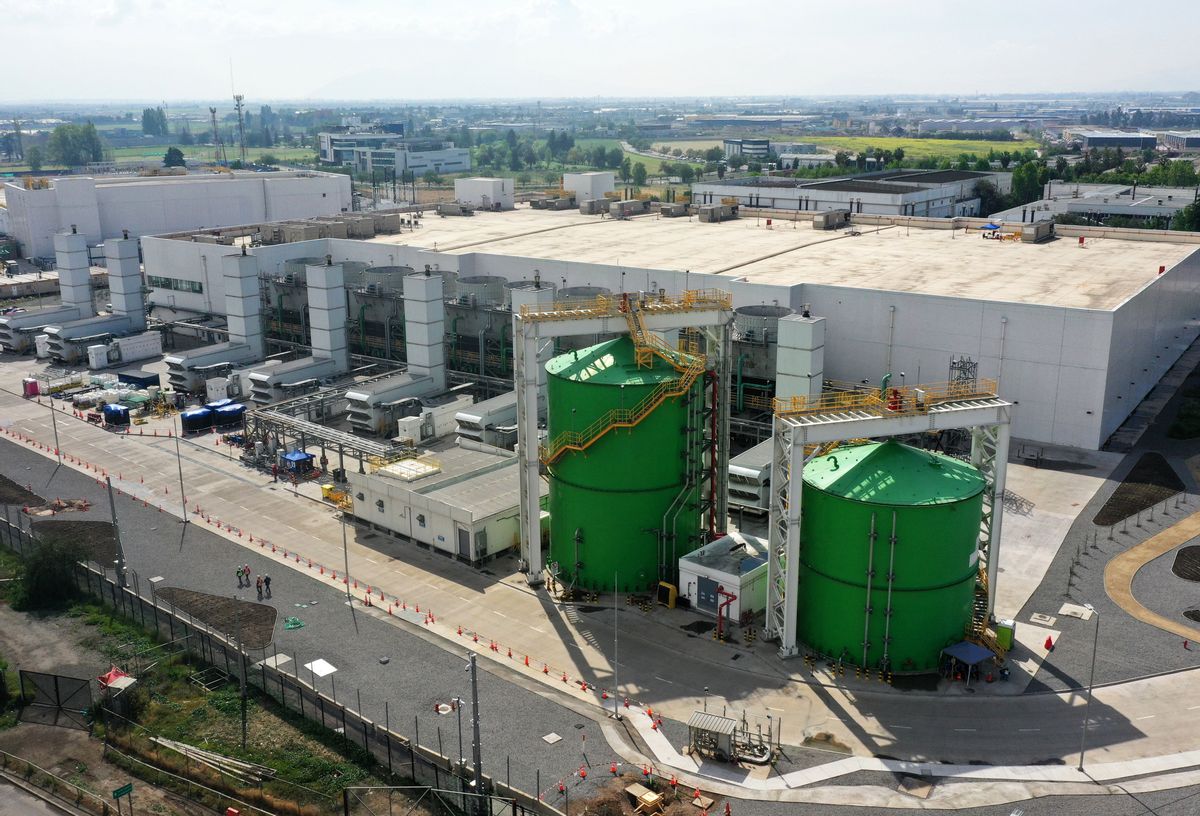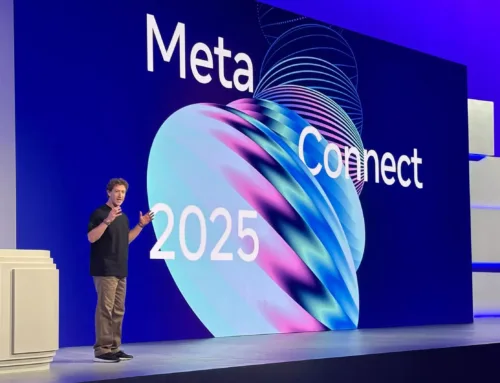AI’s Impact on the Environment, Explained
January 16, 2025
Claims about AI’s environmental cost circulated following the Los Angeles wildfires in early 2025.

Aerial view of a data center owned by Google on October 9, 2024. (Image courtesy of Getty Images)
}
else if(is_tablet()){
slot_number++;
document.write(“”);
}
- Training and using artificial intelligence consumes energy and produces fossil fuel emissions and pollutants. AI has driven significant increases in greenhouse gas emissions from major technology companies and data centers, representing 0.6% of total global greenhouse gas emissions since 2020.
- For example, research has shown that a typical ChatGPT query uses nearly 10 times more energy than an average Google search. Training and using AI also consumes large amounts of fresh water, which is used to cool network servers.
- On the other hand, some studies suggest certain AI applications may actually cause less environmental harm than human labor. Moreover, given how rapidly the technology is evolving, AI might ultimately be used to discover ways to lessen its own environmental impact.
In early January 2025, amid the wildfires in Los Angeles, multiple posts about the impact of artificial intelligence (AI) on climate change circulated widely.
Social media users on X claimed ChatGPT and other AI models are “speeding up the climate crisis” and “contributing to climate change while also drying up water resources” — see posts here (archived) and here (archived). One post (archived) received over 150,000 likes as of this writing:
Debates over the environmental costs of large artificial intelligence language models — a type of program trained on vast amounts of data that can recognize and generate text — have circulated online since the technology first became widely available to the public. ChatGPT, a commonly used example of this kind of AI, was publicly released on Nov. 30, 2022, and a blog post from December 2022 attempted to estimate the AI model’s carbon footprint.
It’s true that training and using large AI models such as ChatGPT consume large amounts of electricity, resulting in the release of greenhouse gas emissions that are harmful to the environment and contribute to climate change. AI queries may also consume large amounts of fresh water, which is used to cool down the computer servers that power AI. But scientists and technology companies are also looking at ways of using artificial intelligence to slow or mitigate the effects of climate change. The exact environmental impact of ChatGPT and AI is still unknown, given how rapidly technology is evolving.
AI’s Environmental Costs
Different AI models use different amounts of energy, so the carbon emissions produced by a single AI query differs accordingly. Shaolei Ren, an associate professor of electrical and computer engineering at the University of California Riverside, estimated that GPT-4, a model made by the creators of ChatGPT, generates roughly a quarter to one-half pound of carbon emissions to write a 100-250 word email. The estimate, which is based on his research, only applies to the United States and may differ depending on the energy efficiency of which country you’re in, Ren told Snopes.
Large-scale AI models are powered by data centers, physical places that house computing equipment and related hardware. Globally, data centers and data transmission networks represented 0.9% of energy-related greenhouse gas emissions and 0.6% of total greenhouse gas emissions in 2020. That’s according to the International Energy Agency (IEA), an intergovernmental organization that provides policy recommendations to 45 countries representing 75% of global energy consumption. Snopes asked the IEA for updated statistics and will add them to the story if we receive them.
A report from the same organization found that “electricity consumption from data centers, artificial intelligence and the cryptocurrency sector” could double from 2022 to 2026, “roughly equivalent to the electricity consumption of Japan.”
Google and Microsoft released sustainability reports in 2024 that also reported significant increases in greenhouse gas emissions, in part due to AI.
Google’s report said its greenhouse gas emissions rose by 48% from 2019 to 2023 — “highlighting the challenge of reducing emissions while compute intensity increases and we grow our technical infrastructure investment to support this AI transition.” Microsoft reported its emissions rose 29.1% from 2020 to 2023 because it was investing “in infrastructure needed to advance new technologies.” In the introduction paragraph, the Microsoft report referred to “new technologies, including generative AI.”
Ren, who studies AI’s social and environmental effects, said it’s difficult to assign a metric for the long-term climate impact of AI. When calculating a cost-benefit analysis, scientists often use a dollar amount assigned to carbon emissions — but estimates vary widely. Ren said calculating AI’s public health impact due to fossil fuels emissions and other pollutants would yield a more concrete metric.
He and his colleagues found in a preliminary December 2024 study — still awaiting peer review as of this writing — that by 2030, the public health impact of U.S. data centers alone will exceed $20 billion a year. According to the report, that’s double the public health impact of U.S. coal-based steelmaking and “comparable to that of on-road emissions of California.” The report also found that training an AI model around the size of Llama3.1, Meta’s AI model, “can produce air pollutants equivalent to more than 10,000 round trips by car between Los Angeles and New York City.”
Addressing Specific Claims
Another common claim circulating on social platforms like Instagram (archived) and Reddit (archived) alleges that a ChatGPT query uses 10 times more electrical energy than a Google search.
Based on the International Energy Agency’s 2024 estimates, that is roughly true — the organization reports that a typical Google search is about 0.3 watt-hours of electricity, compared to 2.9 watt-hours per ChatGPT query. Therefore, a ChatGPT query uses about 9.7 times the amount of energy as a typical Google search.
Some claims reference ChatGPT’s impact on the global fresh water supply — but greatly overestimate it, as in this post on X (archived).
It’s true that data centers use fresh water to cool down the computing servers that power AI. However, research on the water footprint of AI is still emerging. One 2023 University of California Riverside study estimated that GPT-3 “needs to ‘drink’ (i.e., consume) a 500ml bottle of water for roughly 10-50 responses, depending on when and where it is deployed.” Ren, one of the study’s authors, told Snopes that the study passed peer review and is slated for official publication in Communications of the ACM in 2026.
At the time of the study, GPT-3 was the language model underlying ChatGPT, said Ren, which means that the water consumption for ChatGPT queries would have been equivalent to GPT-3’s consumption — but as of this writing, ChatGPT is now using newer models. Ren said that OpenAI, the company that runs ChatGPT, isn’t transparent about the exact models being used for ChatGPT, but it’s likely the company is using newer models like GPT-4 for their chat AI. Estimates that Ren and his colleagues published in a December 2024 study — peer-reviewed and presented at the 2024 Conference on Neural Information Processing Systems — suggested that using GPT-4 to write one 120-200 word email could cost 3 liters of water.
According to the 2023 study, global AI demand “may be accountable for 4.2-6.6 million cubic meters of water withdrawal in 2027,” equivalent to the total water withdrawal of Denmark.
Potential Benefits
Some supporters of AI note that its use may ultimately lessen the environmental impact of humans overall.
For example, a 2024 study in the peer-reviewed journal Scientific Reports found that the carbon emissions produced by writing and illustrating are lower for AI than for humans but that its analyses “do not account for social impacts such as professional displacement.”
Another 2024 study in Scientific Reports found that “while [large learning models, also known as generative AI] have substantial environmental impacts, their relative impacts can be dramatically lower than human labor in the U.S. for the same output.” The study only looked at the environmental costs of human writing compared to AI writing, but Ren said it’s likely these results could be replicated for audio and images. However, he cautioned that the study did not look at the quality of the text written by AI as opposed to human labor. If the text quality from AI is worse and requires more queries and prompts to fix it, that may end up resulting in a higher environmental cost, he said.
That study also noted that “the growing size” of generative AI models “may substantially increase their energy consumption,” thus changing the relative impacts of humans compared to AI. Ren said that on the flip side, programmers will likely figure out how to make AI more energy efficient over time. Right now, programmers are focused on improving AI performance rather than efficiency, he said, which is contributing to the growing energy consumption of generative AI.
An Unknown Future
There’s also an argument for using AI as a tool to mitigate the effects of climate change. The United Nations Environment Programme, for example, uses AI to detect when oil and gas installations vent methane emissions. Artificial intelligence can also optimize the efficiency of power systems, reduce energy consumption in buildings and help design more sustainable infrastructure.
However, AI can also be used in industries that create large-scale environmental harm — including industries of war. According to the United Nations Environment Programme, AI systems “rapidly accelerate the speed and scale of warfare in terms of inflicting harm on both civilians and the environment.”
“Conflicts involving AI-enabled warfare can result in unintended, large-scale damage or destruction to critical resources, such as water supplies, agricultural land and natural reserves, exacerbating the environmental toll of warfare,” the report continues. Destruction of natural reserves and land can also mean the destruction of natural carbon sinks that absorb carbon from the air, which can contribute to climate change.
Overall, scientists are still debating whether AI will ultimately benefit or harm the environment.
“We can measure the carbon emissions, but the benefit part — that depends on the usage scenario,” Ren said.
Sources
Chen, Lin, et al. “Artificial Intelligence-Based Solutions for Climate Change: A Review.” Environmental Chemistry Letters, vol. 21, June 2023, pp. 2525–57, https://doi.org/10.1007/s10311-023-01617-y. Springer. Accessed 14 Jan. 2025.
Google. “Environmental Report 2024.” Gstatic.com , 2024, www.gstatic.com/gumdrop/sustainability/google-2024-environmental-report.pdf. Accessed 14 Jan. 2025.
International Energy Agency. “Data Centres & Networks.” IEA, 11 July 2023, www.iea.org/energy-system/buildings/data-centres-and-data-transmission-networks.
—. “Electricity 2024: Analysis and Forecast to 2026.” Iea.org, 2024, iea.blob.core.windows.net/assets/6b2fd954-2017-408e-bf08-952fdd62118a/Electricity2024-Analysisandforecastto2026.pdf.
Li, Pengfei, et al. “Making AI Less ‘Thirsty’: Uncovering and Addressing the Secret Water Footprint of AI Models.” ArXiv (Cornell University), Cornell University, Apr. 2023, https://doi.org/10.48550/arxiv.2304.03271.
Microsoft. “2024 Environmental Sustainability Report.” Microsoft.com, 2024, cdn-dynmedia-1.microsoft.com/is/content/microsoftcorp/microsoft/msc/documents/presentations/CSR/Microsoft-2024-Environmental-Sustainability-Report.pdf.
Ren, Shaolei, et al. “Reconciling the Contrasting Narratives on the Environmental Impact of Large Language Models.” Scientific Reports, vol. 14, no. 1, Nature Portfolio, Nov. 2024, https://doi.org/10.1038/s41598-024-76682-6. Accessed 14 Jan. 2025.
Tomlinson, Bill, et al. “The Carbon Emissions of Writing and Illustrating Are Lower for AI than for Humans.” Scientific Reports, vol. 14, no. 1, Feb. 2024, p. 3732, https://doi.org/10.1038/s41598-024-54271-x. Accessed 3 Mar. 2024.
United Nations Environment Programme. “AI Has an Environmental Problem. Here’s What the World Can Do about That.” UNEP, 21 Sept. 2024, www.unep.org/news-and-stories/story/ai-has-environmental-problem-heres-what-world-can-do-about. Accessed 14 Jan. 2025.
United Nations Environment Programme, and International Science Council. “Navigating New Horizons: A Global Foresight Report on Planetary Health and Human Wellbeing.” Unep.org, United Nations Environment Programme, 2024, https://doi.org/978-92-807-4166-7. Accessed 14 Jan. 2025.
“);
}
else if(is_tablet()){
document.write(“”);
}
Search
RECENT PRESS RELEASES
Related Post




